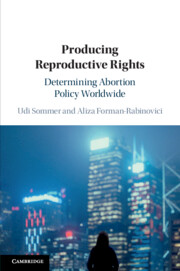Book contents
1 - Introduction: Producing Reproductive Rights
Published online by Cambridge University Press: 27 July 2019
Summary
Functioning as an introduction, in Chapter 1, we first highlight the timeliness of the topic of our book. In the era of the #metoo movement, sustainable development goals, and radical policy changes, such as those in Ireland and Chile, issues of reproductive rights and women’s bodily autonomy continue to be front-page news. The importance of this topic is compounded by the health, moral, and economic implications of abortions (legal and illegal) performed around the world today. We distinguish our book from extant literature and highlight how its cutting edge large-N comparative framework, in combination with case study analyses, provides a first-of-its-kind perspective on questions of abortion around the world. We introduce the three spheres that the book will focus on: civil society, state government, and the international sphere. We then move on to the different theoretical perspectives used in the project and briefly discuss the empirical components as well. We introduce women’s reproductive rights law – – and, specifically, law on access to abortion as a quantifiable and testable variable – – that will lend itself throughout the book to quantitative analyses and hypotheses testing as a part of the discussion on the creation of women’s welfare policy. In closing, we provide a brief overview of the chapters of the book.
Keywords
- Type
- Chapter
- Information
- Producing Reproductive RightsDetermining Abortion Policy Worldwide, pp. 1 - 16Publisher: Cambridge University PressPrint publication year: 2019

